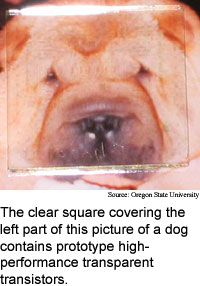
Metals speed clear circuits
Electronic devices that are fast, flexible,
transparent and sturdy require transistors that share these traits. Today's
computer chips contain millions of transistors arranged to form the logic
gates that carry out computing.
Researchers from Oregon State University and Hewlett-Packard Company
have improved the performance of a new type of transparent transistor.
The zinc tin oxide thin-film transistor is transparent, difficult to scratch,
and conducts electricity an order of magnitude faster than previous efforts
using the same class of material.
The thin-film transistors could eventually be used in electronics
that are low-cost, transparent, and/or cover a large area, including giant
screens, transparent switches, smart windows and solar cells, according
to the researchers.
The researchers' transistors have carrier mobilities of 5 to 50
square centimeters per volt second. Carrier mobility is key measure of
how well a transistor conducts electricity. The relatively inexpensive
amorphous silicon and more expensive polycrystalline silicon thin film
transistors commonly used in displays have carrier mobilities of 1.5 to
2, and 100 to 200 square centimeters per volt second, respectively.
The researchers' material is one of a class of materials that
could be used in similar applications, according to the researchers. Amorphous
metal oxides are inexpensive, can be processed at low temperatures, and
the resulting film has a very smooth surface.
The researchers' prototype was processed at a relatively low 300
degrees Celsius. Recent experiments show that it may be possible to fabricate
devices at 50 degrees Celsius, according to the researchers. Low temperature
processing enables more types of surfaces to be coated with the material,
and the smooth surface makes it much easier to coat with other layers
of materials.
The transistors could be ready for commercial use in two to five
years, according to the researchers. The work appeared in the January
3, 2005 issue of Applied Physics Letters.
Nano bridge builds logic
Braille display drives biochip
Adaptive lights organize traffic
Nanotechnology: the physics of the very small
Briefs:
Spray-on photocells harvest infrared
Oil and water drive display
Chemical fuse makes cheap sensors
Metals speed transparent circuits
Plastic records infrared light
Magnetic logic becomes practical
Plastic memory retains data

Research Watch blog
View from the High Ground Q&A
How It Works
RSS Feeds:
News
Ad links:
Buy an ad link
Ad links: Clear History
Buy an ad link
|
TRN
Newswire and Headline Feeds for Web sites
|
© Copyright Technology Research News, LLC 2000-2010. All rights reserved.